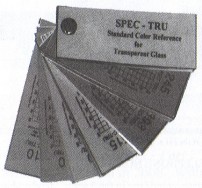The Color Corner
by Ernie Carlson
Reprinted from "Crown Jewels of the Wire", November 2001, page 16
Hello Everyone, and welcome to this 'semi-regular but always occasional'
column on my favorite subject - Color! In the months and years to come I hope to
explore the world of glass colors with you as we attempt to unravel the
mysteries of color names and establish a means of identifying colors using my
trusty Spec-Tru tool.

I also hope to take you inside some specialty collections
to see their amazing range of colors. In this first installment, let me set the
stage for understanding why we need a standardized process for identifying colors, by discussing light sources.
Your Light Source Can Fool You!
Have you ever purchased an insulator only to find that when you put it in the
window at home it appeared to be a different color than what you saw when you
bought it? Blame it on the light source. Incandescent bulbs bum at different
colors of yellow, depending on voltage, and fluorescent tubes contain a large
amount of green light, so either of these sources will affect how you perceive
the color of glass. Colored glass is complex, as metal oxides and impurities in
the glass during manufacture produce many different optical qualities that
affect the wavelengths of colored light that are absorbed, reflected, refracted, and transmitted from
the glass.
So, what kind of light source should we use to see true colors? Well,
the sun would be a good choice, but some days it's bright and other days it's
cloudy, and what if you want to see at night? I use a small light table with a
"full spectrum" fluorescent tube for my light source.
What is a
"full spectrum" tube? There is a new generation of fluorescent lamps
available that feature extremely high CRI values. CRI (Color Rendering Index) is
a unit of measure that defines how well colors are rendered by different
illumination conditions in comparison to a standard such as daylight. For color
identification purposes, I recommend using a lamp with CRI values of 90 and
above. There are a number of "full spectrum" tubes with a CRI of 90
and color temperature of 5000K (such as GE Sunshine lamps) which are available
at most retail stores in 18", 24", and 48" lengths.
So, now that
we have a standard light source, how does this help? Well, at a recent show I
was contemplating the purchase of an insulator whose color was described as
'lime green' by the seller. I checked the insulator on my light table and
discovered that the color was really 'green aqua' which made a big difference on
the final sales price. Now I know that most of you don't carry around a light
table in your back pocket, so let me get up on my soapbox...........
My Challenge to Clubs
I think we need to provide a standard light source for color identification
at all NIA-sanctioned shows, and I think it is the responsibility of the club
hosting the show to provide this light source for use by all attendees. A small
light table can be built for about $25 - plans are available on my website at www.spec-tru.com.
So, here is my challenge: I will donate a Spec-Tru color
identification kit to every club that is willing to provide a standard light
source for color identification at their next show.
That's all for now. Next time I hope to have some information on a Canadian
glass collection, and I will continue the discussion of color identification.
Meanwhile - Happy Collecting!
| 